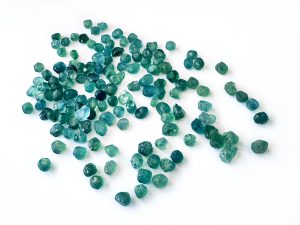Coloured gemstone experts gather in Changsha
By Christie Dang and Dodo To

Coloured gemstone experts met in Changsha in May for the 15th biennial ICA Congress to address vital issues facing the industry. Congress delegates agreed that joint collaborative efforts and strong partnerships through effective stakeholder engagement are crucial to the growth and development of China’s coloured gemstone sector.
Sun Fengming, general secretary of the Gems and Jewellery Trade Association of China (GAC), said China’s RMB6 billion (nearly $1 billion) coloured gemstone market only accounted for 1.3 percent of the total annual value of China’s jewellery retail sector, citing research statistics. In the last five years, China’s gemstone industry was on the fast track, Sun said, underlining the need for collective action and closer cooperation among key industry players to sustain the sector’s growth and development.
Wilson Yuen, immediate past president of ICA, said bringing the ICA Congress to Changsha, the capital city of Hunan Province, was a step in the right direction. The five-day event, which commenced on May 12 and coincided with the first China (Changsha) International Mineral & Gem Show, drew government representatives and experts from various fields including gemstone mining, gemmology, retailing and wholesaling, and jewellery design.
“ICA endeavours to establish a ‘green channel’ for China’s jewellery industry. This year’s congress would hopefully spark productive dialogue among all participants,” Yuen said.
Cut of gems
Yu Xiaojing, president of ICA Congress organising committee, said the association is embarking on an exciting new phase for the strategic growth and transformation of China’s coloured gemstone industry. ICA is advocating the establishment of an International Industrial and Creative Cultural Park in the Changsha Economic and Technological Development Zone. The park aims to serve as a launch pad for gemstone suppliers, cutters and jewellery designers who are expanding into China, and a hub for gemstone education services and gemstone trading.
The industrial cluster, which will occupy about 165 acres, is expected to draw more than 200 leading gemstone companies and generate 100,000 jobs over a five-year period. Businesses located in the park are also anticipated to generate RMB30 billion to RMB50 billion ($5 billion to $8 billion) in turnover annually.


Educating the consumer
Also at the congress, Ke Jie, director of the National Gemstone Testing Center (NGTC), reported on the current developments in China’s coloured gemstone testing and identification system. Gemstone identification is a complicated issue given the variety of gemstone types. Jade, and low-to-medium-quality stones are the items mainly subjected to gem identification tests in China, said Ke, adding that testing is mainly done on finished jewellery. Modern gemstone testing is relatively new to China and technically challenging.
Liu Ge, deputy manager of Beijing Caishikou Jewellery Department Store, said her company started selling coloured gemstones in the early 1990s. at the time, the gemstone section occupied more than 1,000 square meters of retail space. This year, Beijing Caishikou’s coloured gemstone jewellery sales are expected to exceed RMB1 billion ($163 million).
Liu, however, said challengers remain in China’s coloured gemstone market, including low level of product awareness, lack of industry knowledge, “me-too” mentality and the prevalence of generic designs. The industry needs to launch a unified, sustainable consumer education programme for China’s coloured gemstone market to thrive, she continued.
Yang Mingxing, dean of the Gemmological Institute at the China University of Geosciences, focused his talk on higher education and professional training in China’s jewellery industry. He said international designers master the art and craft of metalsmithing before going into jewellery design. Hands-on training and design specialisation are also critical to the success of China’s aspiring designers.
To raise standards of achievement and quality of learning in China’s institutions, schools must consider revising their teaching modules by introducing metalsmithing into coursework listed for freshmen and sophomores, provide better-equipped laboratories, incorporate Chinese traditional craftsmanship into the curriculum, reshuffle the teaching staff and encourage international exchange programmes.
Lu Taijin, chief researcher at the National Gems & Jewelry Technology Administrative Center, delivered a presentation on geographic determination of major coloured gemstones. Liu’s talk touched on the scientific and commercial significance of origin determination, distinct geological environments and sustainability.
Hecliton Santini Henriques, president of the Brazilian Gems & Jewellery Trade Association, underscored the growing importance of Greater China to Brazil’s gemstone industry. About 59 percent of Brazil’s rough production and 45 percent of the South American country’s polished output last year were exported to China and Hong Kong. In 2008, Brazil’s rough and polished exports to China and Hong Kong stood at 50 percent and 16 percent, respectively.
In the first quarter of 2013, Brazil’s rough and polished gemstone exports recorded an increase, Henriques said. Exports to China and Hong Kong in the first three months of the year, however, fell to 55 percent and 29 percent, respectively. Exports to the US however climbed to 66 percent, he continued.
JNA Magazine August 2013

